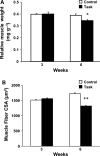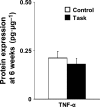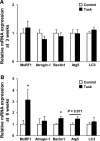Decreased grip strength, muscle pain, and atrophy occur in rats following long-term exposure to excessive repetitive motion
- PMID: 29123982
- PMCID: PMC5666401
- DOI: 10.1002/2211-5463.12315
Decreased grip strength, muscle pain, and atrophy occur in rats following long-term exposure to excessive repetitive motion
Abstract
Work-related musculoskeletal disorders (WMSD) are caused by the overuse of muscles in the workplace. Performing repetitive tasks is a primary risk factor for the development of WMSD. Many workers in highly repetitive jobs exhibit muscle pain and decline in handgrip strength, yet the mechanisms underlying these dysfunctions are poorly understood. In our study, rats performed voluntary repetitive reaching and grasping tasks (Task group), while Control group rats did not perform these activities. In the Task group, grip strength and forearm flexor withdrawal threshold declined significantly from week 2 to week 6, compared with these values at week 0 (P < 0.05). Relative muscle weight and muscle fiber cross-sectional area of flexor digitorum superficialis (FDS) muscles decreased significantly in the Task group, compared with the Control group, at 6 weeks (P < 0.05 and P < 0.01, respectively). Nerve growth factor, glial cell line-derived neurotrophic factor, and tumor necrosis factor α-expression in FDS muscles were not significantly different in Control and Task groups at 3 and 6 weeks. At 6 weeks, the Task group had elevated MuRF1 protein levels (P = 0.065) and significant overexpression of the autophagy-related (Atg) proteins, Beclin1 and Atg5-Atg12, compared with in the Control group (both P < 0.05). These data suggested that long-term exposure to excessive repetitive motion causes loss of grip strength, muscle pain, and skeletal muscle atrophy. Furthermore, this exposure may enhance protein degradation through both the ubiquitin-proteasome and autophagy-lysosome systems, thereby decreasing skeletal muscle mass.
Keywords: autophagy‐lysosome system; grip strength; muscle atrophy; muscle pain; ubiquitin‐proteasome system; work‐related musculoskeletal disorders.
Figures









Similar articles
-
Median nerve injury does not contribute to early onset of decreased grip strength due to repetitive reaching and grasping tasks in rats.Neuro Endocrinol Lett. 2020 Sep;41(2):76-85. Neuro Endocrinol Lett. 2020. PMID: 33185994
-
Performance of repetitive tasks induces decreased grip strength and increased fibrogenic proteins in skeletal muscle: role of force and inflammation.PLoS One. 2012;7(5):e38359. doi: 10.1371/journal.pone.0038359. Epub 2012 May 31. PLoS One. 2012. PMID: 22675458 Free PMC article.
-
Increased serum and musculotendinous fibrogenic proteins following persistent low-grade inflammation in a rat model of long-term upper extremity overuse.PLoS One. 2013 Aug 28;8(8):e71875. doi: 10.1371/journal.pone.0071875. eCollection 2013. PLoS One. 2013. PMID: 24015193 Free PMC article.
-
Spinal substance P and neurokinin-1 increase with high repetition reaching.Neurosci Lett. 2009 Apr 17;454(1):33-7. doi: 10.1016/j.neulet.2009.01.037. Epub 2009 Jan 20. Neurosci Lett. 2009. PMID: 19429049
-
Muscle injury in repetitive motion disorders.Clin Orthop Relat Res. 1998 Jun;(351):21-31. Clin Orthop Relat Res. 1998. PMID: 9646743 Review.
Cited by
-
Effect of Tetragonia tetragonoides (Pall.) Kuntze Extract on Andropause Symptoms.Nutrients. 2022 Oct 31;14(21):4572. doi: 10.3390/nu14214572. Nutrients. 2022. PMID: 36364834 Free PMC article.
-
Reproducibility of the 6-minute walk test in lung transplant recipients.Wien Klin Wochenschr. 2023 Oct;135(19-20):517-527. doi: 10.1007/s00508-022-02132-w. Epub 2022 Dec 28. Wien Klin Wochenschr. 2023. PMID: 36576557 Free PMC article.
-
Blocking CCN2 Reduces Established Palmar Neuromuscular Fibrosis and Improves Function Following Repetitive Overuse Injury.Int J Mol Sci. 2023 Sep 8;24(18):13866. doi: 10.3390/ijms241813866. Int J Mol Sci. 2023. PMID: 37762168 Free PMC article.
-
Blocking substance P signaling reduces musculotendinous and dermal fibrosis and sensorimotor declines in a rat model of overuse injury.Connect Tissue Res. 2020 Nov;61(6):604-619. doi: 10.1080/03008207.2019.1653289. Epub 2019 Aug 23. Connect Tissue Res. 2020. PMID: 31443618 Free PMC article.
-
Effects of Tyrosine and Tryptophan Supplements on the Vital Indicators in Mice Differently Prone to Diet-Induced Obesity.Int J Mol Sci. 2021 May 31;22(11):5956. doi: 10.3390/ijms22115956. Int J Mol Sci. 2021. PMID: 34073081 Free PMC article.
References
-
- Ranney D, Wells R and Moore A (1995) Upper limb musculoskeletal disorders in highly repetitive industries: precise anatomical physical findings. Ergonomics 38, 1408–1423. - PubMed
-
- Barbe MF, Elliott MB, Abdelmagid SM, Amin M, Popoff SN, Safadi FF and Barr AE (2008) Serum and tissue cytokines and chemokines increase with repetitive upper extremity tasks. J Orthop Res 26, 1320–1326. - PubMed
LinkOut - more resources
Full Text Sources
Other Literature Sources

